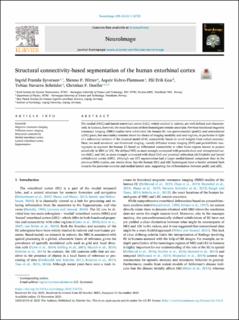| dc.description.abstract | The medial (MEC) and lateral entorhinal cortex (LEC), widely studied in rodents, are well defined and characterized. In humans, however, the exact locations of their homologues remain uncertain. Previous functional magnetic resonance imaging (fMRI) studies have subdivided the human EC into posteromedial (pmEC) and anterolateral (alEC) parts, but uncertainty remains about the choice of imaging modality and seed regions, in particular in light of a substantial revision of the classical model of EC connectivity based on novel insights from rodent anatomy. Here, we used structural, not functional imaging, namely diffusion tensor imaging (DTI) and probabilistic tractography to segment the human EC based on differential connectivity to other brain regions known to project selectively to MEC or LEC. We defined MEC as more strongly connected with presubiculum and retrosplenial cortex (RSC), and LEC as more strongly connected with distal CA1 and proximal subiculum (dCA1pSub) and lateral orbitofrontal cortex (OFC). Although our DTI segmentation had a larger medial-lateral component than in the previous fMRI studies, our results show that the human MEC and LEC homologues have a border oriented both towards the posterior-anterior and medial-lateral axes, supporting the differentiation between pmEC and alEC. | en_US |

